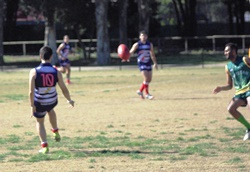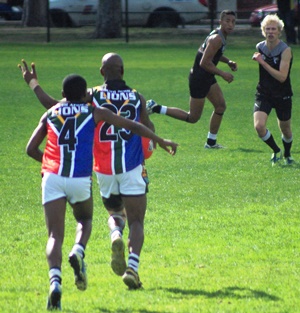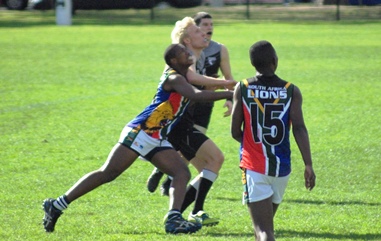TRAINING FOR SIX. Chapter 4: Training for Four
- Friday, March 11 2016 @ 01:30 pm ACDT
- Contributed by: Troy Thompson
- Views: 2,466

 By Matt Zurbo this originally appeared on The Footy Almanac website here. A great reference for those nights you only have few get to training.
By Matt Zurbo this originally appeared on The Footy Almanac website here. A great reference for those nights you only have few get to training.
Training for Four
Two on two. That’s a match!
Warm Up
Try a random warm-up. Handball however you want to in a thirty meter radius to each other, at the on-coming, over shoulders, deliberately at ankles, hard at the gut of someone passing, soft to the person running by. Try to fan wherever possible, it’s the new craze. That mean run by in the same diction the ball handler received it, fanning across the oval. None of it more than half to ¾ pace. Get puffing. Stretch a bit. Do the same with kicking. Stretch more. Ready to go.
*******************
- The Fan
Many variations of the Fan. Try this, or invent your own. The Diamond. All facing down the ground in a diamond, staring on the back flank. Player at tip has ball, all others take off. Player with ball handballs towards player running on inside of corridor, player from behind sprints to get in on the corridor side of them, player who did not get it on the their side runs across to get off them from in front, player who started the drill has pushed across to get it off them. Four quick handballs in the same direction. Fanning to the middle of the ground. Set up, go again. Repeat length of ground, shoot when in range.
*******************
- The Release
Three players in triangle. Forth about twenty meters back. Three players fire of rapid, in close handballs, as soon as forth player is sprinting by wide, wide handball goes out. Lone player, now with ball, pushes on (three HARD steps) until twenty meters away. Two of the three join lone player, forming another triangle. New left behind player. Repeat.
Sometimes pivot and deliver, sometimes you are facing the wide receiver. It is all about learning timing. Not being mechanical. Do not plan who the one who fires the handball out. When wide player is in the slot, deliver. 
*******************
- The Greg Williams.
Maybe I’m dating myself, but I have never, ever seen a better handballer. A tougher in and under. Williams was a C.H.A.M.P.I.O.N, even if he did play for Carlton.
Two teams of two. A&C, B&D. A and B stand beside each other. One of the others throws the ball in at their ankles. They compete. TRY TO KEEP YOUR FEET. Each teammate crabs the edge of the contest, trying to stay chest on with their teammate, so when it gets fired out, bang, they are there. Throw it straight back in at ankles. First to get it out to teammate three times win. A and B swap with B and D, who are now the competitors.
Drill is about fighting for ball and firing it off from pack quick. But also, for the receiver to not just watch, but to talk and crab and make sure they are front and centre.
*******************
- The Craig Bradley. Haha!
Most younger crew won’t remember who he was. A brilliant, brilliant outside runner on the receiving end of Greg Williams handballs. Not the bravest but brave in pain barriers. He ran like nobody before him. Was vital to Carlton.
Anyways…
Similar to the Greg Williams. A and B stand ready to compete for ankle ball. But this time only C is front and centre, and D is twenty back, crabbing. D learns to time their run, depending on contest. In the twist and turn of A and B competing and C edging to be front and centre to it, all players must be smart. If the ball comes out on the other side to C, D sees it about to happen and runs for the long release handball. If A or B win it defensive side to goal hopefully they will handball long to running D, ignoring C in close.
Drill teaches competing, release, timing and OPTIONS.
Again, first to three, then swap roles.
*******************
- Kicking Warm-Up
Again, Fanning, it’s the buzz!
Four players thirty apart.
- Spot kick five laps to left.
- Spot kick five laps to right.
- Kick ball high, mark, push back, turn, spot kick to next player, three laps
- Four way Yo-yo, three laps (see Training for Two)
- Four way lead away. (see Training for Three)
If you’re well drilled should only take about five-seven minutes yet get heaps of touches and be well warm.
*******************
Drill 1. Downhill Skiing.
All four start on goal line. Player with ball switches, and you’re all away working down ground. For drill’s sake, whoever gets marks ball stops until nearest player stands mark. Then, play on, or go back and chip, or whatever, as other teammates dictate. Handball is play on, mark is to be held up with a man on the mark.
Work way down ground.
Too often chip goes to back pocket, then nobody is moving. With this it is follow-up, follow-up, follow-up. You are the next chip wide. You are the next chip over the top. You are the next switch wide. You are the next handball. You deliver and say, “Right, where do I push to next?”
Also, with the next closest standing the mark, you learn attack/defend/attack/defend, all the way down the ground.
Once you get good, if you are fit, as a coach, you adapt the drill.
“Okay, only kick or chip it to someone who is running AT you.” Even if it is from the side or you have to push up and double back. Very hard.
You set standards.
“Okay, our aim is to make it down to the other 50, have a shot. Then do the same on the way back. Each time the ball hits the ground we have to start again, though.”
Decisions, decisions, decisions. I fucking love them!
*******************

Two competitors, one handball release, and a switch.
The handball release throws the ball at the feet of the competitors. They have to get it to the switch. They can use the release player if they want. The release player will be on the side of whoever gives it to them.
The key to this drill is, as soon as the ball is thrown at the feet of the competitors. The switch player gets on their bike. Be wide sometimes, be in for the long handball. Be behind the play, be forward of it. Be in the middle for the line-breaking spot kick. Be back and across for the switch kick. Work!
The idea of being somewhere different each time is, the competitors will learn to spot the player who is free, rather than just go through routines.
The release player is the quarterback. They are the one doing all the talking/encouraging.
Teams must be predictable to each other. You learn there is always a release player out back, to quickly spot a switch or chip into the corridor.
Five goes for the competitors, then switch roles with the two outside players.
Great drill for on-ballers and half back flankers.
*******************
Drill 3. Ebb and Go.
Goals time. Full back, leader on left, leader on right, drifter in middle.
Player on left leads hard for kickout. Drifter works across to them, so they get the ball off them, WHILE RUNNING GOALWARD, three HARD steps, and shoot. Then take off for player on right. Player on right leads hard. By this time fullback has gathered ball and kicks to lead. Drifter repeats for player on right. Gets handball or chip of player on right while running goalward, three hard steps, shoots, pushes back to left. Five shots. Rhythm, running through the ball, kicking goals on the run while tired. So often you will get the first two or three and miss the rest. When you have had your five shots, everybody rotate.
Drifter is almost working to a figure eight.
P.S. Fullback, mark at full stretch, run through goal line, take off! Three hard steps, steady, really drill the pass so the leader doesn’t have to break stride. Push back hard without turning your back to the play. Be well ready for shot. Good workout. Practice good habits.
Drill 3 Variation Ebb and Go.
Fullback has ball, three players are spread out around 40 from goal. All lead in any direction. Fullback kicks to player of choice. If marked flat footed or on back foot, must chip or handball to someone on front foot for goal. So once you have done your lead and it didn’t go to you, you must immediately push to where the ball is, so you can get it. Always, three hard steps, run through ball and goal.
If you can mark the ball from kickout moving forward, run through it, continue on and kick goal.
The full back should be mixing up their kicks. If it has gone long, a good one is one of the other leads then runs in for the chip to thirty out, and the player in between charges to get the handball off them, for running goal.
Full back, if kicked long, and player marked outside fifty, should occasionally take off as if full forward for lead and mark.
*******************
Drill 4. Four to one.
All four players about 40 out. Throw ball up. It’s on. All four against each other. As soon as you kick a goal, you are out. Breather. The other three must then repeat. Then two. Winners and losers. Competitive natures. Football.
If the ball goes out of bounds or for a point, play is started again from 40.
*******************
Drill 5. Easiest Kick In Football.
Even with kick-out strategies there will be players leading left and right. The easiest kick in football is if you have led to the right and it has gone to the left. Almost always the middle will now be empty. If you turn and go, at, say 45 degrees towards the middle of the ground, there will almost always be an uncontested chip into the corridor and your team is away. Ideally there would then be running backmen, ball-carriers streaming by you if you could not take off yourself. Suddenly, the ball is in the forward line before they have had a chance to defensively set up.
So, for this drill: Fullback, player leading left, one leading right, for deep pocket kick-out. Player in middle reads play to stand on mark of left player or right, depending on which one the fullback kicked to. The player who was not kicked to sprints to top on centre square for easy chip.
Set-up again, repeat.
*******************
Easiest Kick In Football II
Once you have the hang of this, expand. Adapt.
One player leads to left. On right, one leads short, one leads long. Think like footballers. If ball goes left, two on right take off towards middle of ground. Player on left now has short chip and long centre of ground options.
OR only one of you take off for middle, the other stay for the switch.
Player on left, once they have switched, runs for player in middle, gets handball off running into forward half.
Always think two kicks ahead.
If player on left goes to longer option, closer option then runs to get handball on way through.
IF ball gets kicked to short lead on right, long lead keeps running down the ground while player on left runs into middle for chip. Player with ball chips, runs, gets handball back and delivers to third player, now in attacking half.
IF ball gets kicked to long lead on right, they can turn and go
OR prop and chip to player on left who has now pushed into middle for chip. Player who was the short right lead runs through to get handball off and drive into forward line.
Each time the ball passes the middle, jog back, kick ball to fullback and go again.
Once you are good at this, the fullback can then also be an option. If the kick is deep to left or right pocket the fullback can then sprint into corridor for chip, to link up long switch. OR mark and give back to player running through for one-two and switch.
Small groups so often only practice goal kicking. I have no idea why.
*******************
Drill Whatever. CMS; Contested Mark and Spread.
One player has the ball fifty away. Kicks it 45 to contested mark. Player A and B move into flight of ball and compete.
As much a I don’t like cones, set up three for this drill. One for kicker, one for starting point for A and B, one for kicker to aim at. Only the burliest full forward gets to stand and deliver. The rest of us have to run to the flight of the ball.
Player C roves, starting from side and moves forward or back of the contest as the flight of the ball requires. Basic, established rules apply.
If a mark is taken, Player C spreads, receives handball or the chip wide, gets ball and puts in three hard steps, delivers a 30 meter chip to ball kicker, everybody jogs back to their spot.
If a mark is taken while Player C is front and centre, C gets the handball, and the two markers, A and B, spread for Player C (no u-turns) to handball back to one of them, who runs for three hard steps, steadies, and kicks to kicker.
If mark is taken on front foot, keep running with it and deliver it yourself.
If ball is not marked, all three improvise, working on basic principles. No u-turns. Spread wide. Run across or behind player who gets ball on back foot, play on if you get ball on front foot.
The point is, once the ball is contested, it should become reflex that your job is not done. Big marking players have to learn to do more than just mark. They must land ready to be further involved.
Once one of the two contesting markers has three marks, swap.
Lastly, once you have done this for a few weeks, adapt. When three down contested end get control of the all, kicker then does hard lead – out wide, at player coming at him, whatever – so when the ball comes back it is a sharp chip to a player on the move. All four of you then jog back to your positions.
*******************
Drill Another -Two On Goal
Set up two sets of goals in middle of ground, about 50 apart. Two versus two, but, really, one-on-one with each team having a player out back. If you can’t get through, fire a handball out back to teammate who kicks a goal. Reload. First to five goals wins.
Teaches, to both always have, and always look for, release player out back.
And kick goals.
*******************
The Wind Down.
Goal kicking, as you wish. Just goof around having shots for five or ten minutes. Although, if ball doesn’t go to you, try and push over and stand on mark, put light pressure on as they play on. Even if only for every second or third shot.
Jog. Stretch.
Rehydrate, eat a carb.
Beer (if you are of legal drinking age).
Next time - we skip five - and go to Training for Six.


 RSS news
RSS news Twitter
Twitter Facebook
Facebook